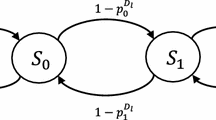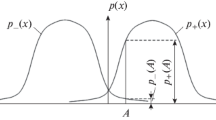Abstract
In this paper, we propose an improved structure for M-dimension(M ⩾ 2) turbo codes using M identical component encoders. The presented structure only applies single recursive convolutional encoder to encode M interleaved versions of information sequence and single tail sequence to operate termination. For the commonly used two-dimension (M = 2) turbo codes, two cascade soft input soft output (SISO) decoders are detailed to decode the corresponding codes. With the two cascade SISO decoders, this coding structure obviously outperforms traditional turbo codes at high code rates, especially, about 0.3 dB gain can be obtained at code rate 0.9 in additive white Gaussian noise channel with quadrature phase shift keying modulation. This makes the proposed coding structure very attractive for future radio communication systems with high throughput requirements.
Similar content being viewed by others
References
Berrou C, Glavieux A. Near optimum error correcting coding and decoding: Turbo-codes [J]. IEEE Trans on Commu, 1996, 44(10): 1261–1271.
Divsalar D, Pollara F. Multiple turbo codes for deep-space communications, JPL, TDA Prog Rep, 42-121 [R]. Pasadena: JPL, 1995.
Hokfelt J, Edfors O, Maseng T. On the theory and performance of trellis termination methods for turbo codes [J]. IEEE J Sel Areas Commun, 2001, 19(5): 838–847.
van Stralen N, Ross J, Anderson J. Tailbiting and decoding recursive systematic codes [J]. Electronic Letters, 1999, 35(17): 1461–1462.
Jing S, Takeshita O Y. Extended tail-biting schemes for turbo codes [J]. IEEE Commu Letters, 2005, 9(3): 252–254.
Letzepis N, Grant A. Bit error rate estimation for turbo decoding [J]. IEEE Trans on Commu, 2009, 57(3): 585–590.
Robertson P, Hoeher P, Villebrun E. Optimal and sub-optimal maximum a posteriori algorithms suitable for turbo decoding [J]. European Trans on Telecomm, 1997, 8(2): 119–126.
3GPP. Multiplexing and channel coding (Release 8) [EB/OL]. [2009-09-19]. http://www.3gpp.org/ftp/Specs.
Takeshita O Y. On maximum contention-free interleavers and permutation polynomials over integer rings [J]. IEEE Trans on Inform Theory, 2006, 52(3): 1249–1253.
Nimbalker A, Blankenship Y, Classon B, et al. Contention-Free interleavers for high-throughput turbo decoding [J]. IEEE Trans on Commu, 2008, 52(8): 1258–1267.
Cheng J F, Nimbalker A, Blankenship Y, et al. Analysis of circular buffer rate matching for LTE turbo code [C]//Proc IEEE Vehicular Technology Conference 2008. Singapore: IEEE Press, 2008: 1–5.
Author information
Authors and Affiliations
Corresponding author
Additional information
Foundation item: Supported by the National Natural Science Foundation of China (60762005)
Biography: WANG Zhenghai, male, Ph.D. candidate, research direction: channel coding and information theory.
Rights and permissions
About this article
Cite this article
Wang, Z., Tian, M. & Wang, Y. Improving the structure of multiple dimension turbo codes using multiple identical component encoders. Wuhan Univ. J. Nat. Sci. 15, 330–334 (2010). https://doi.org/10.1007/s11859-010-0661-3
Received:
Published:
Issue Date:
DOI: https://doi.org/10.1007/s11859-010-0661-3




